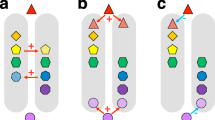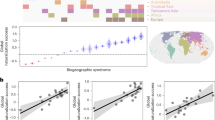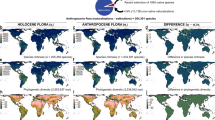Abstract
All around the globe, humans have greatly altered the abiotic and biotic environment with ever-increasing speed. One defining feature of the Anthropocene epoch1,2 is the erosion of biogeographical barriers by human-mediated dispersal of species into new regions, where they can naturalize and cause ecological, economic and social damage3. So far, no comprehensive analysis of the global accumulation and exchange of alien plant species between continents has been performed, primarily because of a lack of data. Here we bridge this knowledge gap by using a unique global database on the occurrences of naturalized alien plant species in 481 mainland and 362 island regions. In total, 13,168 plant species, corresponding to 3.9% of the extant global vascular flora, or approximately the size of the native European flora, have become naturalized somewhere on the globe as a result of human activity. North America has accumulated the largest number of naturalized species, whereas the Pacific Islands show the fastest increase in species numbers with respect to their land area. Continents in the Northern Hemisphere have been the major donors of naturalized alien species to all other continents. Our results quantify for the first time the extent of plant naturalizations worldwide, and illustrate the urgent need for globally integrated efforts to control, manage and understand the spread of alien species.
This is a preview of subscription content, access via your institution
Access options
Subscribe to this journal
Receive 51 print issues and online access
$199.00 per year
only $3.90 per issue
Buy this article
- Purchase on Springer Link
- Instant access to full article PDF
Prices may be subject to local taxes which are calculated during checkout



Similar content being viewed by others
References
Steffen, W., Grinevald, J., Crutzen, P. & McNeill, J. The Anthropocene: conceptual and historical perspectives. Phil. Trans. R. Soc. A 369, 842–867 (2011)
Lewis, S. L. & Maslin, M. A. Defining the Anthropocene. Nature 171, 171–180 (2015)
Simberloff, D. et al. Impacts of biological invasions: what’s what and the way forward. Trends Ecol. Evol. 28, 58–66 (2013)
Richardson, D. M. et al. Naturalization and invasion of alien plants: concepts and definitions. Divers. Distrib. 6, 93–107 (2000)
Blackburn, T. M. et al. A proposed unified framework for biological invasions. Trends Ecol. Evol. 26, 333–339 (2011)
di Castri, R. in Biological Invasions: a Global Perspective (eds Drake, J. A. et al.) 1–30 (John Wiley, 1989)
Lonsdale, W. M. Global patterns of plant invasions and the concept of invasibility. Ecology 80, 1522–1536 (1999)
Elton, C. S. The Ecology of Invasions by Animals and Plants Ch. 4, 77–93 (Methuen, 1958)
Blackburn, T. M., Cassey, P. & Lockwood, J. L. The island biogeography of exotic bird species. Glob. Ecol. Biogeogr. 17, 246–251 (2008)
Fridley, J. D. Of Asian forests and European fields: eastern U.S. plant invasions in a global floristic context. PLoS ONE 11, e3630 (2008)
Richardson, D. M. & Rejmánek, M. Trees and shrubs as invasive alien species – a global review. Divers. Distrib. 7, 788–809 (2011)
Lowe, S., Browne, M., Boudjelas, S. & De Poorter, M. 100 of the World’s Worst Invasive Alien Species (The Invasive Species Specialist Group (ISSG), 2000)
Pereira, H. M. et al. Essential biodiversity variables. Science 339, 277–278 (2013)
Brummit, R. K. World Geographical Scheme for Recording Plant Distributions Edition 2 (Hunt Institute for Botanical Documentation, 2001)
Scheiner, S. M. Six types of species-area curves. Glob. Ecol. Biogeogr. 12, 441–447 (2003)
Brickell, C. & Cathey, H. M. American Horticultural Society A–Z Encyclopedia of Garden Plants (DK Publishing, 2004)
Cullen, J., Knees, S. G. & Cubey, H. S. The European Garden Flora (Cambridge Univ. Press, 2011)
Crisp, M., Cook, L. & Steane, D. Radiation of the Australian flora: what can comparisons of molecular phylogenies across multiple taxa tell us about the evolution of diversity in present-day communities? Phil. Trans. R. Soc. Lond. B 359, 1551–1571 (2004)
Heywood, V. H. & Sharroc, S. European Code of Conduct for Botanic Gardens on Invasive Alien Species (Council of Europe, 2013)
Denslow, J. S. Weeds in paradise: thoughts on the invasibility of tropical islands. Ann. Mo. Bot. Gard. 90, 119–127 (2003)
Kier, G. et al. A global assessment of endemism and species richness across island and mainland regions. Proc. Natl Acad. Sci. USA 106, 9322–9327 (2009)
Rejmánek, M. in Biodiversity and Ecosystem Processes in Tropical Forests (eds Orians, G. H., Dirzo, R. & Cushman, J. H. ) 153–172 (Springer-Kluwer, 1996)
Fridley, J. D. et al. The invasion paradox: reconciling pattern and process in species invasions. Ecology 88, 3–17 (2007)
Keller, W., Li, B. & Shiue, C. H. China’s foreign trade: perspectives from the past 150 years. World Econ. 34, 853–892 (2011)
Darwin, C. On the Origin of Species by Means of Natural Selection, or the Preservation of Favoured Races in the Struggle for Life (John Murray, 1859)
Lambdon, P. W. et al. Alien flora of Europe: species diversity, temporal trends, geographical patterns and research needs. Preslia 80, 101–149 (2008)
Pyšek, P. et al. Alien plants in checklists and floras: towards better communication between taxonomists and ecologists. Taxon 53, 131–143 (2004)
Kalwij, J. M. Review of ‘The Plant List, a working list of all plant species’. J. Veg. Sci. 23, 998–1002 (2012)
R Core Team. R: a language and environment for statistical computing v.3.1.2 (R Foundation for Statistical Computing, 2014)
Cayuela, L. & Oksanen, J. Taxonstand: taxonomic standardization of plant species names v.1.6 (R Foundation for Statistical Computing, 2014)
Oksanen, J. et al. Vegan: community ecology package v.2.0-10 (R Foundation for Statistical Computing, 2013)
Joppa, L., Visconti, P., Jenkins, C. N. & Pimm, S. L. Achieving the convention on biological diversity’s goals for plant conservation. Science 341, 1100–1103 (2013)
Scholes, R. J. et al. in Africa Environment Outlook 2 Ch. 7, 226–261 (African Ministerial Conference on the Environment and United Nations Environment Programme, 2006)
Tutin, T. G., et al. Flora Europaea (Cambridge Univ. Press, 1964–1980)
Abel, G. J. & Sander, N. Quantifying global international migration flows. Science 343, 1520–1522 (2014)
Acknowledgements
We thank the DAISIE team, the CONABIO team, E. Zykova, J. K. Vinogradova, S. R. Majorov, M. Schmidt, M. Newman, P. Thomas, R. Pooma, S. McCune, S. S. Tjitrosoedirdjo, H. Roy, S. Rorke, J. Danihelka, Z. Barina, A. Zeddam, S. Masciadri, Z. Barina and P. Nowak for data contributions, Z. Sixtová, B. Rüter, E. Mamonova, M. Krick, O. Michels and T. Scheu for digitizing data and internet searches, G. Müller and J. Moat for help with shapefiles, L. Cayuela for help with the R package Taxonstand, and T. Blackburn, A. Meyer and M. Rejmánek for comments on previous versions of the manuscript. M.v.K. and W.D. acknowledge funding by the Deutsche Forschungsgemeinschaft (KL 1866/9-1). F.E. acknowledges funding by the Austrian Climate and Energy Fund (project number KR11AC0K00355, SpecAdapt). J.P. and P.P. were supported by the Centre of Excellence PLADIAS (Czech Science Foundation project number 14-36079G) and long-term research development project RVO 67985939 (The Czech Academy of Sciences). P.P. acknowledges support by Praemium Academiae award from The Czech Academy of Sciences. M.W. and M.S. acknowledge funding from the Helmholtz Centre for Environmental Research (UFZ) and the German Centre for Integrative Biodiversity Research (iDiv) Halle-Jena-Leipzig (DFG FZT 118). P.W. and H.K. acknowledge funding from the Deutsche Forschungsgemeinschaft (DFG) Free Floater Program in the Excellence Initiative at the University of Göttingen and in the scope of the BEFmate project from the Ministry of Science and Culture of Lower Saxony. H.S. acknowledges support by the German VW-Foundation. F.J.C. and M.V. acknowledge support of the project Flora de Guinea Ecuatorial, 4 (CGL2012-32934). N.F. thanks the Projects ICM 05-002, PFB-23 and Fondecyt Postdoc 3120125. J.T. acknowledges the support of the Research Center of the College of Science, King Saud University, Riyadh, Saudi Arabia.
Author information
Authors and Affiliations
Contributions
M.v.K., P.P., W.D., F.E., J.P., E.W., M.W., H.K. and P.W. are the core GloNAF project members, who searched for and coordinated the collection of inventories of naturalized alien plants. M.v.K. and P.P. digitized the inventories and standardized the taxonomic names. J.K., N.M., L.A., J.B., F.C., D.C., J.C.-T., N.C., E.C., C.C., A.E., E.F., N.F., Q.G., L.H., I., A.K., S.M., J.M., O.M., D.M., D.N., A.P., P.P., M.P.B., M.P., M.S., H.S., W.S., J.T., M.V. and J.W. contributed naturalized plants inventories or other data. M.v.K. led the analyses and writing, with major inputs from P.P., W.D., F.E., J.P., M.W., H.K. and P.W., and further inputs from all other authors.
Corresponding author
Ethics declarations
Competing interests
The authors declare no competing financial interests.
Extended data figures and tables
Extended Data Figure 1 Observed and expected numbers of naturalized species from each donor TDWG continent in each of the recipient TDWG continents.
Histograms of the expected numbers are shown in black open bars, and are based on 999 random draws from the global flora (n = 337,137). The observed numbers are shown as vertical lines; blue, significantly fewer observed naturalized species from the source continent than expected (in the lower 2.5 percentile); red, significantly more observed naturalized species than expected (in the upper 2.5 percentile); black, the observed number of naturalized species is within the central 95% range of the expected numbers.
Supplementary information
Supplementary Information
This file contains Supplementary Text. (PDF 67 kb)
Supplementary data
This file contains Supplementary data. (XLSX 264 kb)
Rights and permissions
About this article
Cite this article
van Kleunen, M., Dawson, W., Essl, F. et al. Global exchange and accumulation of non-native plants. Nature 525, 100–103 (2015). https://doi.org/10.1038/nature14910
Received:
Accepted:
Published:
Issue Date:
DOI: https://doi.org/10.1038/nature14910
This article is cited by
-
Invading plants remain undetected in a lag phase while they explore suitable climates
Nature Ecology & Evolution (2024)
-
Effects of biogeographical origin on the flowering phenology of exotic plant communities
Biological Invasions (2024)
-
Prioritizing weeds for biological control development in the western USA: adaptation of the Biological Control Target Selection system
BioControl (2024)
-
Traits of insect herbivores and target weeds associated with greater biological weed control establishment and impact
BioControl (2024)
-
Are the anthropized Cerradão of the Cerrado-Pantanal ecotone resistant to alien species invasion?
Brazilian Journal of Botany (2024)
Comments
By submitting a comment you agree to abide by our Terms and Community Guidelines. If you find something abusive or that does not comply with our terms or guidelines please flag it as inappropriate.



